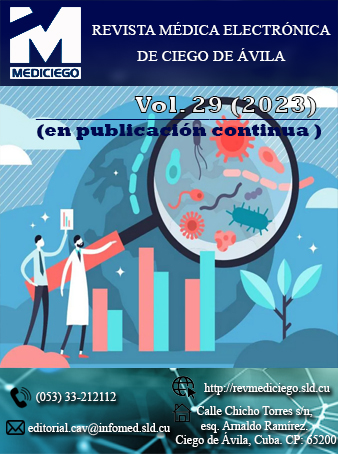Quemado crítico extremo recuperado. Informe de caso
Palabras clave:
quemaduras, resultados de cuidados críticos, supervivencia, unidades de quemadosResumen
Introducción: la piel es la barrera protectora del organismo, expuesta a las agresiones y en particular a las quemaduras. La pérdida de una parte sustancial de este órgano es incompatible con la vida. La rapidez y la calidad de los cuidados del caumatólogo son factores esenciales para la supervivencia del paciente.
Objetivo: presentar el caso de un paciente crítico extremo con el 95 % de su superficie corporal quemada, de interés debido a su supervivencia.
Presentación del caso: paciente masculino, adulto de 31 años de edad, blanco, con antecedentes de salud. Sufre lesiones por quemaduras dermohipodérmicas estimadas de un 95 % de superficie corporal, tras un accidente de tránsito. Se realiza tratamiento local y general intensivo, así como tratamiento de las complicaciones. Se aplica cura oclusiva, hidratación estricta por protocolo, heteroinjerto de la hermana y zenoinjertos con piel leofilizada de cerdo para cubiertas temporales y autoinjertos seriados y oportunos como cubiertas definitivas. Además, tratamiento enérgico y correcto de las complicaciones con antibióticoterapia pertinente, atención multidisciplinaria durante su evolución. A los 95 días se decide alta hospitalaria con seguimiento ambulatorio por consulta externa.
Conclusiones: el quemado crítico representa un desafío en el plano médico. La forma holística en que es tratado desde su ingreso hasta su rehabilitación es clave para la recuperación del paciente. El reto actual está en reforzar los centros de atención para permitir la entrega oportuna de sus necesidades.
Descargas
Citas
Valdés-Mesa S, Palacios-Alfonso I, Mariño-Fernández JA. Presentación de caso. Tratamiento integral del paciente gran quemado. Rev Cub Med Mil [Internet]. 2015 [citado 13 Feb 2015];44(1):130-8. Disponible en: http://scielo.sld.cu/pdf/mil/v44n1/mil16115.pdf
Ministerio de Salud (Chile). Guía Clínica. Manejo del paciente gran quemado [Internet]. Santiago de Chile: Minsal; 2016 [citado 13 Feb 2015]. Disponible en: http://www.bibliotecaminsal.cl/wp/wp-content/uploads/2016/04/GPC-GRAN-QUEMADO-FINAL-18-MARZO-2016_DIAGRAMADA.pdf
Ministerio de Salud (Chile). Guía Clínica. Gran Quemado. [Internet] Santiago de Chile: Minsal; 2007 [citado 13 Feb 2015]. Disponible en: https://www.minsal.cl/portal/url/item/7222d6a3774f3535e04001011f01482e.pdf
Arriagada IC. Manejo multidisciplinario del gran quemado Rev. Med. Clin. Condes [Internet]. 2016 [citado 13 Feb 2015];27(1):38-41] Disponible en: https://www.elsevier.es/es-revista-revista-medica-clinica-las-condes-202-pdf-S0716864016000079
Borges-Muñío H. Manual de procedimientos diagnóstico y tratamiento en caumatología y cirugía plástica. La Habana: Pueblo y Educación; 1984:25-33.
Burgos-Frías N. Estudio predictivo de las necesidades transfusionales del paciente quemado quirúrgico y validación del método [Internet]. Madrid: Universidad Autónoma de Madrid; 2017 [citado 13 Feb 2015]. Disponible en: https://repositorio.uam.es/bitstream/handle/10486/681591/burgos_frias_natalia.pdf?sequence=1
Calderón-Martínez JC. Quemaduras: principales complicaciones y factores relacionados. [Internet]. Veracruz: Universidad Veracruzana; 2014 [citado 13 Feb 2015]. Disponible en: https://www.uv.mx/blogs/favem2014/files/2014/06/PROTOCOLO-Cesar.pdf
Sánchez-Sánchez M, García de Lorenzo-Mateos AM. Fluidoterapia en los pacientes quemados críticos [Internet]. Barcelona: Fresenius Kabi España; 2008 [citado 13 Feb 2015]. Disponible en: http://www.univermedios.com/wp-content/uploads/2018/08/FLUIDOTERAPIA-EN-LOS-PACIENTES-QUEMADOS-CR%C3%8DTICOS.pdf
Pérez-Boluda M, Lara-Montenegro J, Ibáñez-Mata J, Cagigal-González L, León-Llerena CM. Guía de actuación ante el paciente quemado [Internet]. Málaga: Hospital Regional Universitario Carlos Haya; 2006 [citado 13 Feb 2015]. Disponible en: https://es.slideshare.net/azanero33/paciente-quemado-3091216
García-Urquijo A, Rodríguez-Rodríguez J, Rodríguez-Pérez R, Lorenzo-Manzanas R, Hernández-González G. Staphylococcusaureusen quemaduras: estudio de incidencia, tendencia y pronóstico. Cir. plast. Iberolatinoam [Internet]. 2015 [citado 19 Ago 2015];41(2):127-34. Disponible en: http://scielo.isciii.es/pdf/cpil/v41n2/original2.pdf
Moya-Rosa EJ, Moya-Corrales Y, Mesa-Gutiérrez A. Diagnóstico por estudio bacteriológico cuantitativo de la infección en la herida por quemadura. AMC [Internet]. 2020 [citado 13 Feb 2015];24(1):89-99. Disponible en: http://scielo.sld.cu/pdf/amc/v24n1/1025-0255-amc-24-01-e6711.pdf
Khaliq MF, Noorani MM, Siddiqui UA, Al Ibran E, Rao MH. Factors associated with duration of hospitalization and outcome in burns patients: a cross sectional study from Government Tertiary Care Hospital in Karachi, Pakistan. Burns [Internet]. 2013 [citado 03 Dic 2019];39(1):[aprox. 5 p.]. Disponible en: https://www.clinicalkey.es/service/content/pdf/watermarked/1-s2.0-S0305417912001258.pdf?locale=es_ES&searchIndex
Publicado
Cómo citar
Número
Sección
Licencia
Derechos de autor 2023 Bertha Luzardo Iglecia

Esta obra está bajo una licencia internacional Creative Commons Atribución-NoComercial 4.0.
Aquellos autores/as que tengan publicaciones con esta revista, aceptan los términos siguientes de la Licencia CC Attribution 4.0/ International/ Deed (CC BY 4.0):
Usted es libre de:
- Compartir — copiar y redistribuir el material en cualquier medio o formato para cualquier propósito, incluso comercialmente.
- Adaptar — remezclar, transformar y construir a partir del material para cualquier propósito, incluso comercialmente.
La licenciante no puede revocar estas libertades en tanto usted siga los términos de la licencia
Bajo las condiciones siguientes:
- Atribución — Usted debe dar crédito de manera adecuada , brindar un enlace a la licencia, e indicar si se han realizado cambios . Puede hacerlo en cualquier forma razonable, pero no de forma tal que sugiera que usted o su uso tienen el apoyo de la licenciante.
- No hay restricciones adicionales — No puede aplicar términos legales ni medidas tecnológicas que restrinjan legalmente a otras a hacer cualquier uso permitido por la licencia.
La revista no se responsabiliza con las opiniones y conceptos emitidos en los trabajos, son de exclusiva responsabilidad de los autores. El Editor, con la asistencia del Comité de Editorial, se reserva el derecho de sugerir o solicitar modificaciones aconsejables o necesarias. Son aceptados para publicar trabajos científico originales, resultados de investigaciones de interés que no hayan sido publicados ni enviados a otra revista para ese mismo fin.
La mención de marcas comerciales de equipos, instrumentos o materiales específicos obedece a propósitos de identificación, no existiendo ningún compromiso promocional con relación a los mismos, ni por los autores ni por el editor.






















